Video consultations - public and clinician views: consultation report
Consultation report of the national public engagement exercise held during June to August 2020, to understand the general public and health professionals’ views on using Near Me video consulting.
2 Analysis of responses to the online public survey
2.1 Introduction
The online public survey was launched on 29th June and closed on 31st July with 4,025 responses received. The questions explored views on a range of factors around current and future use and possible benefits and barriers of having an appointment by video. The list of benefits and barriers were pre-set based on experience from the Near Me leads and feedback from public members, third sector organisations and health care professionals as part of co-producing the survey. Nevertheless, there was the option to offer further suggestions and wider critique.
2.2 Methodology
2.2.1 Quantitative analysis
The survey was anonymous, and no ethical approval was required. The survey tool with analytics and graphics used was QuestBack.
Simple descriptive analysis has been undertaken including some cross tabulation to look at the relationship between a range of variables and whether this altered findings. Analysis was not carried out to consider statistical significance between some of the responses. Further analysis will be carried out on the full data set through Oxford University.
2.2.2 Qualitative analysis
For several questions there was an opportunity to expand on answers (via free text comments). The large sample size offers opportunities to explore themes in more detail but was outside of the scope of the initial analysis. They were however informally reviewed.
2.3 Summary of who responded to the online survey
2.3.1 Demographic profile
The demographic profile of the survey respondents is summarised. Age of responders ranged from 16 to 92. Over half (54%) were in the age bands 45-54 and 55-64 (combined). Slightly more people responded in the over 75 band, when compared to 0-24. There was a heavy bias towards female responders (81%) (Figure 2 and Table 1).
Figure 2 Distribution of responses by age band
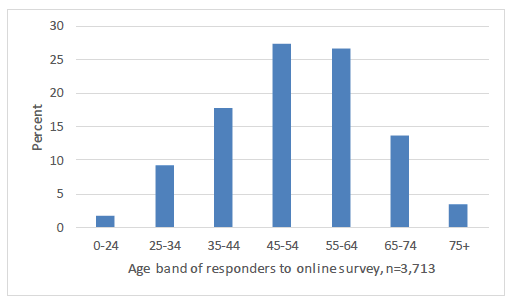
Figure description:
Responders to the survey were grouped by age bands (0-24, 25-34, 35-44, 45-54, 55-64, 65-74 and 75 and over). Age of responders ranged from 16 to 92. Over half (54%) were in the age bands 45-54 and 55-64 (combined). Slightly more people responded in the over 75 band, when compared to 0-24.
Of the respondents who provided their ethnicity, 97.5% identified themselves as white. Around one in five (18.1%) considered themselves to have a disability (Table 1).
| Characteristic | Category | No. | Percent |
|---|---|---|---|
| Gender | Male | 724 | 18.7 |
| Female | 3133 | 80.9 | |
| Non-binary | 16 | 0.4 | |
| 3,873 | |||
| Age band | 0-24 | 67 | 1.8 |
| 25-34 | 346 | 9.3 | |
| 35-44 | 657 | 17.7 | |
| 45-54 | 1,019 | 27.4 | |
| 55-64 | 989 | 26.6 | |
| 65-74 | 506 | 13.6 | |
| 75+ | 129 | 3.5 | |
| Total | 3,713 | ||
| Self-reported disability | Yes | 702 | 18.1 |
| No | 3,172 | 81.9 | |
| Total | 3,874 | ||
| Ethnicity | White | 3,723 | 97.5 |
| Mixed or Multiple ethnic groups | 26 | 0.7 | |
| Asian | 30 | 0.8 | |
| African | 6 | 0.2 | |
| Caribbean or Black | 4 | 0.1 | |
| Other, ethnic group | 30 | 0.8 | |
| Total | 3,819 |
Responses were received from across all 14 territorial health boards with only a small number of respondents stating that that they did not know what their health board was. Five health boards accounted for some two thirds of all responses to this question (Table 2).
| Health board | Population of health board | Number responses | Percent of responses | Number per 100k[11] | Rank |
|---|---|---|---|---|---|
| I do not know | 0.3 | ||||
| NHS Ayrshire & Arran | 369,670 | 290 | 7.4 | 78 | 7 |
| NHS Borders | 115,270 | 56 | 1.4 | 49 | 12 |
| NHS Dumfries & Galloway | 148,790 | 102 | 2.6 | 69 | 9 |
| NHS Fife | 371,910 | 179 | 4.5 | 48 | 13 |
| NHS Forth Valley | 306,070 | 239 | 6.1 | 78 | 7 |
| NHS Grampian | 584,550 | 671 | 17.1 | 115 | 5 |
| NHS Greater Glasgow & Clyde | 1,174,980 | 512 | 13.0 | 44 | 14 |
| NHS Highland | 321,800 | 307 | 7.8 | 95 | 6 |
| NHS Lanarkshire | 659,200 | 355 | 9.0 | 54 | 11 |
| NHS Lothian | 897,770 | 510 | 13.0 | 57 | 10 |
| NHS Orkney | 22,190 | 60 | 1.5 | 270 | 2 |
| NHS Shetland | 22,990 | 47 | 1.2 | 204 | 3 |
| NHS Tayside | 416,080 | 521 | 13.2 | 125 | 4 |
| NHS Western Isles | 26,830 | 76 | 1.9 | 283 | 1 |
| Total | 3,925 |
2.3.2 Awareness, experience, and confidence
Before participating in the survey almost six out of ten (58%) of respondents had heard about the Near Me service; 41% stating they had not, and less than one percent were 'unsure'. One in four (25%) had prior experience of a Near Me video appointment (c.f. 75% who had not).
More generally, most participants had experience of using a range of video conferencing systems for social reasons, work, and/or education. Of the seven systems listed the most frequently used were WhatsApp (74%), Zoom (67%) and Facebook messenger (61%). Less than one in ten (8%) did not use technology for social reasons or work purposes (Table 3).
| Device | Percent |
|---|---|
| 73.9% | |
| Zoom | 66.6% |
| Facebook Messenger | 61.3% |
| Facetime | 53.0% |
| Skype | 40.2% |
| Microsoft Teams | 36.9% |
| Other | 10.6% |
| None | 7.8% |
| Google Meet | 6.9% |
| Number of responses | 3974 |
Access to a video calling device, like a smartphone, tablet or computer with webcam was very high (95%); four percent responded that they did not have access to such a device and one percent 'did not know'. The four percent are interpreted as having access to a device but with no webcam.
Almost four out of five (78.7%) who responded stated that they were confident using video calls (Figure 3).
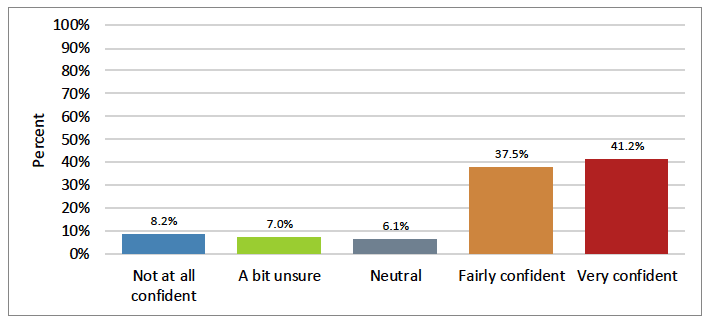
Figure description:
Almost four out of five (79%) who responded stated that they were confident using video calls; 8% were not at all confident, 7% a bit unsure and 6% neutral.
2.3.3 How representative is the survey?
To help interpret the results, the characteristics of survey respondents were compared with best known estimates for Scotland.
Similar, to other public consultations, female respondents were over-represented and, in this case, considerably so (80%) compared to 51.5% in the general population and consequently males very under-represented (18.7%) versus 49.5%. This was even more marked than typically reported.
As of 30th June 2019, Scotland's population was 5.46 million, according to statistics published by National Records of Scotland (April 2020). In 2019, just under one in five people (19%) in Scotland were aged 65 and over. In this survey 17.1% of those who responded were 65 or over. The working age group (aged 16-64 years) make up 64% of the population whereas in this survey represented around 80%.
The ethnicity of survey respondents was slightly under representative when compared to the estimates reported in the 2011 Census.
The number of people responding to the survey who reported as having a disability (18.1%) which was close to the 2011 Census estimate of 20%. Based on the Scottish Surveys Core Questions 2020, however the figure is slightly higher with 25% of adults in Scotland reported as having a limiting long term physical or mental health problem
While five health boards accounted for some two thirds of all responses, when adjusted for size of population covered by each health board, all island boards had proportionately more responses, and of the mainland boards, NHS Tayside, followed by NHS Grampian and NHS Highland had most responses per 100,000 (Figure 4, Table 2).
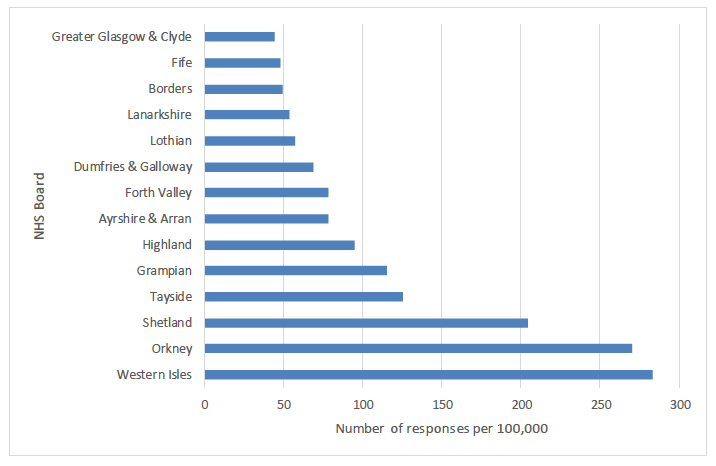
Figure description:
There are 14 territorial health boards in Scotland as listed in Table 2. Responses ranged from less than 50 to over 250, per 100,000. The three island boards (NHS Orkney, NHS Shetland, and NHS Wester Isles) had proportionately more responses, and of the mainland boards, NHS Tayside, followed by NHS Grampian and NHS Highland had most responses per 100,000. Boards with the lowest responses were NHS Greater Glasgow and Clyde, NHS Fife, and NHS Border.
2.4 Findings on views on having health and care appointments by video
Should video consulting should be offered for health and care appointments?
Almost nine out of ten people (86.5%) thought that video consulting should be offered for health and care appointments (as appropriate) (Figure 5).
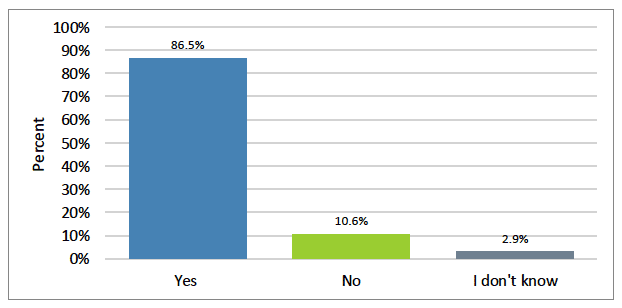
Figure description:
87% thought video should be used for health appointments; 11% did not think video should be used and 3% were not sure.
The analysis was re-run to control for gender, disability, age band, health board, previous use of Near Me and support for appointments by video. There was little difference in views between females and males (87.1% vs 87.8) or for people with or without a self-reported disability (83.3% v 81.6%).
Respondents aged 35 to 64 were more likely to be supportive of video consulting ranging from 90-92%. There was a drop-off in older age groups 65-74 (82%) which further reduced in 75+ age band to 76% (Figure 6).
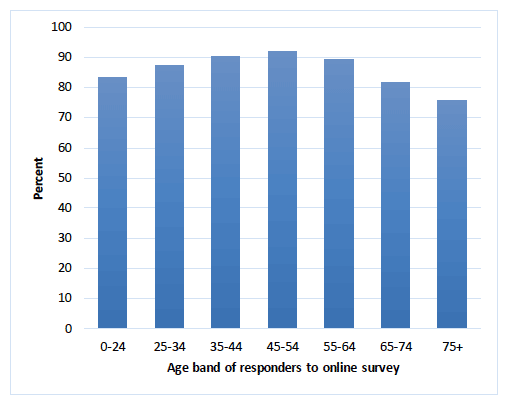
Figure description:
Responders to the survey were grouped by age bands (0-24, 25-34, 35-44, 45-54, 55-64, 65-74 and 75 and over). Respondents aged 35 to 64 were more likely to be supportive of video consulting ranging from 90-92%. There was a drop-off in older age groups 65-74 (82%) which further reduced in 75+ age band to 76%.
Those who were aged 75 and over were more likely to feel they would benefit from some support to use Near Me, followed by those who were 24 and under (small sample), Figure 7.
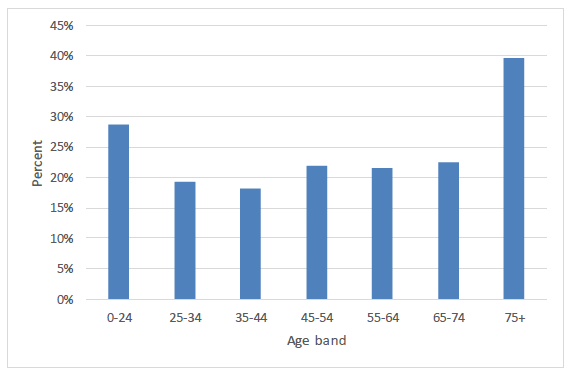
Figure description:
Those who were aged 75 and over were more likely to feel they would benefit from some support to use Near Me, followed by those who were 24 and under.
There was some variation in health board on who thought Near Me appointments should be offered ranging from 83% to 89%. The only notable exception was for NHS Shetland where 96% responded that video consultations should be offered (N=47). Previous use of Near Me made it slightly more likely to recommend the use of Near Me (90.5% v 84.3%), statistical significance not tested.
Preferences
Respondents were asked to consider their preferences around three types of appointments: face to face, telephone and video consultation (Figure 8).
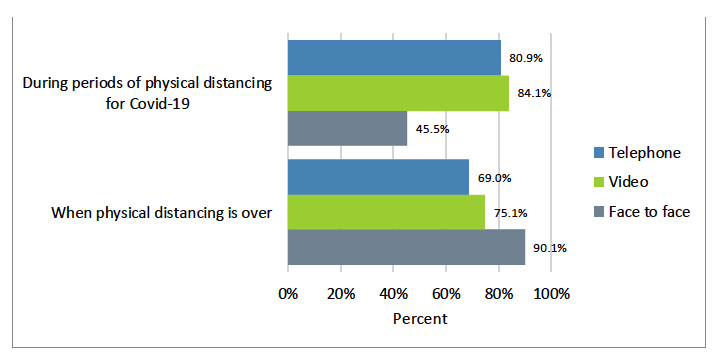
Figure description:
Respondents were asked to consider their preferences around three types of appointments: face to face, telephone and video consultation. During physical distancing, video (84%) was preferred over telephone (81%) and less than half (46%) selecting face to face. Once there are no restrictions due to physical distancing 90% said they would prefer face to face; video was still preferred over the telephone (75% v 69%).
During Covid-19, video (84%) was slightly preferred over telephone (81%) with less than half (46%) selecting face to face.
For all three appointments types, preferences would change, once physical distancing is over; respondents were now twice as likely to prefer a face to face appointment (90% v 46%). Notably, however, appointment by video was still preferred over the telephone (75.1% v 69%).
Just over half (54%) described certain scenarios where they thought video would not be appropriate for them. This generated a list of almost 2,000 free text comments (1,983). These will be explored in further detail as part of Independent Evaluation including comparing views of the public versus healthcare professionals.
Benefits and barriers
The survey included questions on possible benefits (advantages) and barriers (disadvantages) of having an appointment by video consultations. Average scores are calculated and go from 1 (strongly disagree) to 5 (strongly agree).
Benefits
From the list of possible benefits of using Near Me respondents were asked to rate the importance to them. Overall average scores ranged from 3.1 to 4.2, where a lower score indicates that respondents considered the feature to be less of a benefit Benefits that scored the highest (i.e. favourable) were lower infection risk (4.2), improved access to services (4.1), with more convenient and saves time both scoring 4.0 The potential benefit which scored lowest was 'easier to have a relative / carer to support their appointment' (Figure 9).
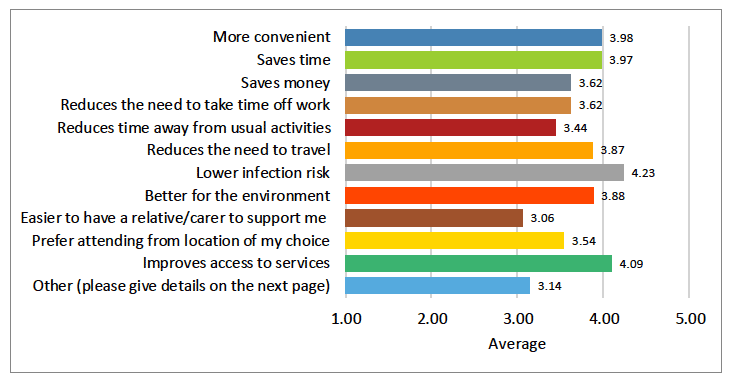
Figure description:
Responders were asked to rate the importance of several potential benefits to them on a scale of 1 to 5, where 5 is most beneficial. The top four benefits of using video appointments: it lowers infection risk (4.2), improves access to services (4.1), more convenient (4.0) and saves time (4.0).
Over 1,000 free text comments were submitted for this question. These were wide ranging including setting out additional benefits as well as responding that some of the options listed were not a 'benefit' from some people's perspective. These free text comments require detailed quantitative analysis to determine any themes or extremes.
A breakdown of the benefits - showing significance of each - is presented on page 27.
Barriers
Turning to the potential barriers, the range of relative scores were overall lower 2.2 to 3.2. Poor internet connectivity (3.2), no private space for a call and no or limited access to a device (2.8) were felt to be the biggest barriers to overcome. The category that scored highest was 'other' with over 2,500 free text comments provided which are still to be analysed (Figure 10).
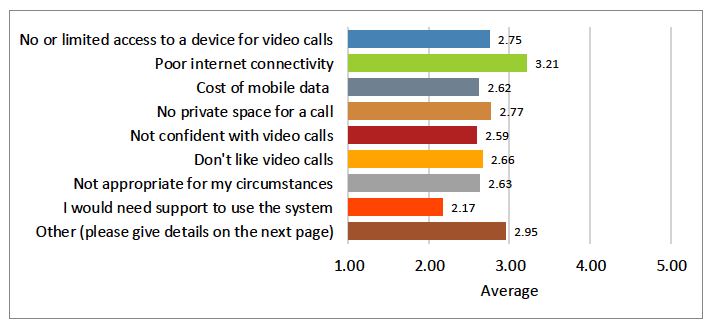
Figure description:
Responders were asked to rate the barriers on a scale of 1 to 5 where 5 poses the biggest barrier. No or limited access to a device (2.3), poor internet connectivity (2.3), cost of mobile data (2.4), no private space for a call (1.2), not confident video with video calls (2.2), don’t like video calls (2.4), not appropriate for my circumstances (2.3).
When responses were grouped into either positive or negative (ie, "very significant" and "a little significant" combined) this had no change in the order of the top three barriers (Table 4 and Figure 11).
| Barrier | Percent Significance | New rank order | Original rank order |
|---|---|---|---|
| Poor internet connectivity | 45.6 | 1 | 1 |
| No private space | 32.9 | 2 | 2 |
| No or limited access to a device | 32.2 | 3 | 3 |
| Not confident with video calls | 29.2 | 4 | 7 |
| Do not like video calls | 29.0 | 5 | 4 |
| Cost of mobile data | 28.0 | 6 | 6 |
| Not appropriate for my circumstances | 24.4 | 7 | 5 |
| I would need support to use the system | 19.1 | 8 | 8 |
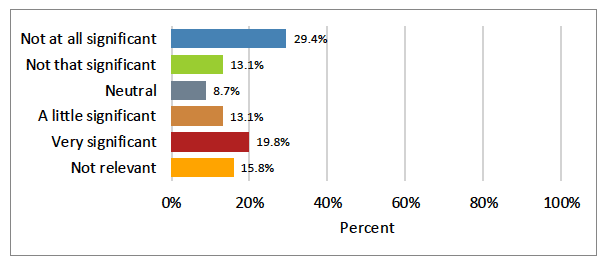
Figure description:
29% thought having no private space for a call was not at all significant, 13% not that significant, 9% were neutral, 13% a little significant, 20% very significant and 16% not relevant.
Potential improvements
In response to the question 'What would make it easier for you to use video consulting'?, excluding those who said they would not need any support, free internet and improved connectivity were highlighted reflecting the barriers earlier identified (Figure 12).
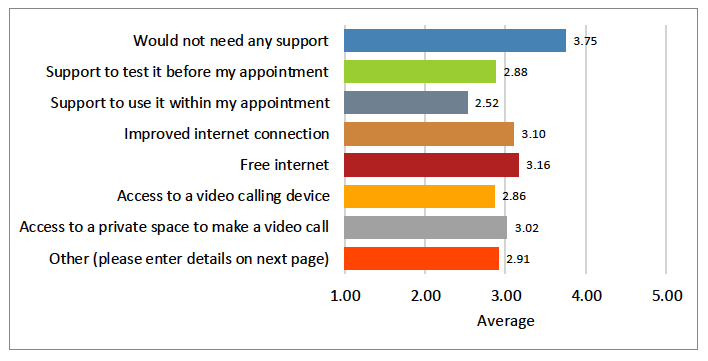
Figure description:
Various factors were identified that might make it easier for people to use video on a scale of 1 to 5 where five would help the most. The top three were: Free internet (3.2), improved internet connection (3.1) and access to private space to make a call (3.0). The average scored for those who did not need support was 3.8.
Support for improved internet connectivity were explored by health board with responders in agreement varying from 31% (NHS Tayside) to 57% (Dumfries and Galloway). In most cases there is likely to be huge variation within board areas and any future analysis might be better carried out via the postcode data which was also collected (Figure 13).
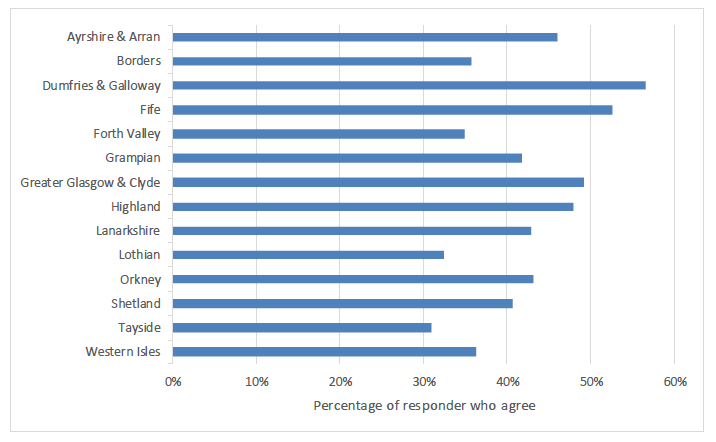
Figure description:
Support for improved internet connectivity was explored by health board with responders to the survey in agreement that better connectivity would make it easier to use Near me varying from 31% (NHS Tayside) to 57% (Dumfries and Galloway).
Contact
Email: NSS.TEC@nhs.net
There is a problem
Thanks for your feedback